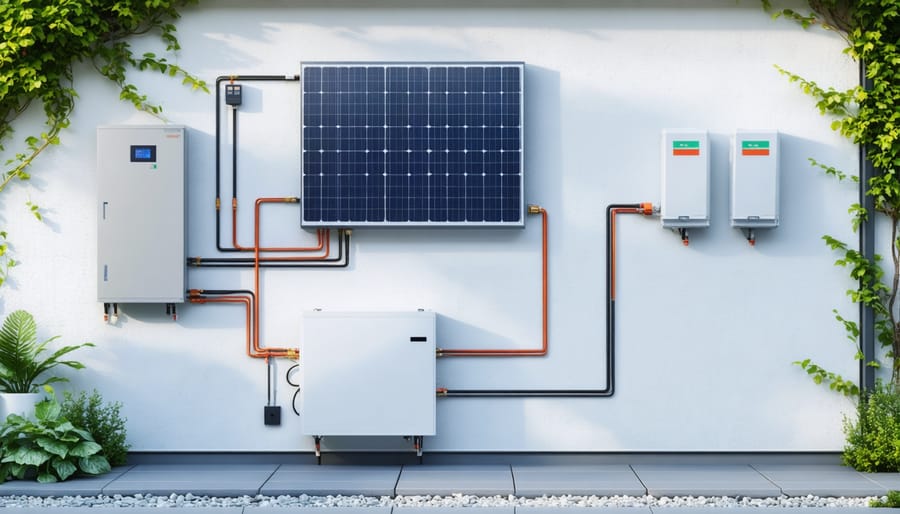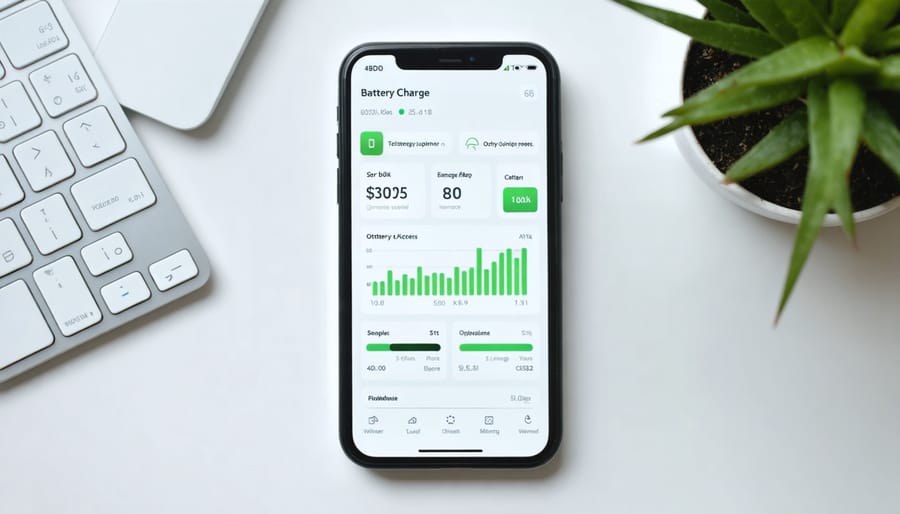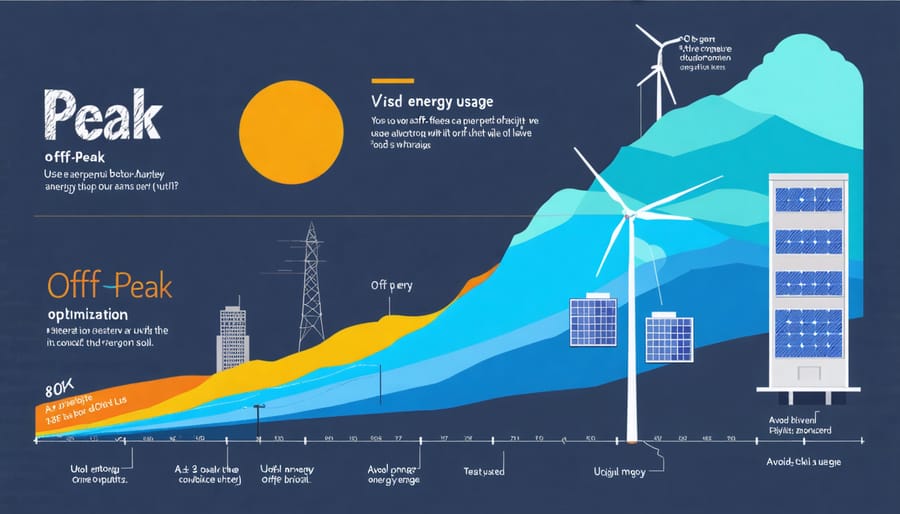Optimize your Battery Energy Storage System (BESS) performance by scheduling deep discharges during peak rate hours, maximizing your return on investment while extending battery life. Program your system to store excess solar energy during mid-day production peaks, especially if you’re considering installing solar panels or expanding your existing array. Monitor and adjust charge/discharge cycles seasonally to account for changing energy demands and solar production patterns.
Smart BESS optimization combines cutting-edge technology with practical energy management, helping homeowners slash electricity bills while supporting grid stability. By fine-tuning your battery storage system’s settings and understanding your household’s unique energy patterns, you can achieve up to 30% better efficiency and significantly reduce your carbon footprint.
The key to successful BESS optimization lies in balancing three crucial factors: maximizing self-consumption of solar energy, taking advantage of time-of-use electricity rates, and maintaining optimal battery health. With proper configuration and regular monitoring, your battery storage system becomes not just an energy backup, but a powerful tool for energy independence and cost savings.

What Makes BESS Optimization Critical for Your Home Solar System
Energy Bill Reduction Through Smart Battery Management
Smart battery management can significantly reduce your monthly energy bills by optimizing how and when you use stored power. While the initial cost of solar installation may seem substantial, proper BESS optimization helps maximize your return on investment through strategic energy usage.
The key to reducing bills lies in programming your battery system to charge during off-peak hours when electricity rates are lowest and discharge during peak periods when rates are highest. This practice, known as peak shaving, can cut your energy costs by up to 30% in some cases.
Your battery system can be set to automatically switch to stored power during daily peak rate periods, typically in the early evening when solar production decreases but household energy demand rises. By drawing from your battery instead of the grid during these expensive rate periods, you avoid paying premium prices for electricity.
Additionally, smart battery management systems can learn your household’s energy consumption patterns and adjust charging cycles accordingly, ensuring you always have enough stored power when you need it most.
Extended Battery Life and System Longevity
Proper battery optimization doesn’t just enhance daily performance – it significantly extends the lifespan of your entire energy storage system. By implementing smart charging cycles and maintaining optimal depth of discharge levels, you can protect your investment for years to come. Most home battery systems are designed to last 10-15 years, but with proper optimization, you can push that timeline even further while maintaining strong performance.
Temperature management plays a crucial role in battery longevity. Keeping your battery system within recommended temperature ranges through proper ventilation and installation locations prevents premature aging and capacity loss. Regular monitoring and adjusting charge/discharge patterns based on seasonal changes helps maintain optimal operating conditions year-round.
The financial benefits of extended battery life are substantial. Every additional year of operation increases your return on investment and reduces the overall cost per kilowatt-hour stored. Plus, maintaining higher efficiency throughout the battery’s lifetime means you’ll consistently save more on your energy bills. Smart optimization strategies essentially pay for themselves through reduced replacement costs and improved long-term performance.
Key BESS Optimization Strategies for Homeowners
Time-of-Use Rate Optimization
Time-of-Use (TOU) rates can be a game-changer for maximizing your battery storage system’s value. By programming your BESS to charge when electricity rates are lowest and discharge during peak-rate periods, you can significantly reduce your monthly energy bills.
Start by obtaining your utility provider’s TOU rate schedule, which typically divides the day into off-peak, mid-peak, and peak periods. Program your battery system to charge during off-peak hours, usually late at night or early morning, when electricity costs are at their lowest. Then, set it to discharge during peak hours – typically late afternoon and early evening – when rates can be two to three times higher.
For optimal results, consider these programming strategies:
– Set your battery to charge to full capacity during the lowest-rate period
– Reserve enough stored energy to cover your household’s needs during peak-rate hours
– Adjust seasonal settings to account for changing peak periods
– Enable smart features that automatically respond to rate changes
Many modern BESS systems come with user-friendly apps that make programming straightforward. These apps often include visualization tools to help you track savings and adjust settings for better performance. Some systems even offer automated optimization features that learn your consumption patterns and adjust charging/discharging schedules accordingly.
Remember to review and update your settings periodically, especially when utilities adjust their rate schedules or your household’s energy usage patterns change.

Weather-Based Charging Patterns
Weather patterns play a crucial role in optimizing your battery energy storage system’s performance. By understanding and adapting to weather forecasts, you can maximize your solar energy capture and minimize reliance on grid power. On sunny days, your system can prioritize charging batteries during peak sunlight hours, typically between 10 AM and 2 PM, ensuring maximum storage capacity for evening use.
During cloudy or rainy periods, smart BESS systems can automatically adjust their charging patterns. They might draw more power from the grid during off-peak hours when electricity rates are lower, helping maintain your energy independence while keeping costs down. This weather-based approach becomes particularly valuable during seasonal changes, where daylight hours and solar production vary significantly.
Modern BESS optimization systems often integrate with weather forecasting services to plan ahead. For instance, if tomorrow’s forecast predicts heavy cloud cover, your system might charge more fully today while solar production is optimal. Similarly, during extended periods of predicted poor weather, your system can implement conservation modes to stretch stored energy further.
The system can also adapt to seasonal patterns. In summer, when solar production is high, it might focus on storing excess energy for air conditioning use. During winter, it could prioritize evening heating needs by ensuring batteries are fully charged before sunset. This dynamic adjustment ensures you’re always making the most of your solar investment while maintaining comfort and efficiency.

Load Shifting and Peak Shaving
Load shifting and peak shaving are powerful strategies that can significantly reduce your energy costs when using a battery energy storage system (BESS). During peak hours, when electricity rates are highest, your BESS can automatically switch to stored power instead of drawing from the grid. This smart optimization helps you avoid expensive time-of-use rates while maintaining your normal power consumption.
Think of your BESS as a personal energy bank that saves money during costly peak periods. By charging your battery when rates are low (typically at night) and using that stored energy when rates are high (usually afternoon and early evening), you can substantially reduce your monthly electricity bills. This process works seamlessly with your solar panel voltage output to ensure optimal energy management.
Most modern BESS systems come with smart controllers that can automatically predict peak periods and adjust charging/discharging cycles accordingly. This means you don’t have to manually monitor energy prices or usage patterns – your system handles it all automatically. Some users report savings of up to 30% on their electricity bills through effective load shifting and peak shaving.
For maximum benefit, consider programming your BESS to prioritize running major appliances during off-peak hours. This might include charging electric vehicles, running pool pumps, or operating air conditioning systems when electricity costs are lowest.
Smart Technology Integration for Better BESS Performance
Home Energy Management Systems
Home Energy Management Systems (HEMS) are revolutionizing the way homeowners interact with their battery storage systems. These smart platforms act as the brain of your home’s energy ecosystem, automatically managing power flow to maximize your solar savings and battery efficiency.
Modern HEMS use advanced algorithms to learn your household’s energy patterns and adjust accordingly. They can predict when you’ll need more power, prepare for weather changes, and even respond to time-of-use pricing from your utility company. For example, your system might automatically charge your batteries during off-peak hours and discharge them when electricity rates are highest.
These systems also provide user-friendly mobile apps that give you real-time insights into your energy usage. You can monitor battery levels, track solar production, and view energy consumption patterns from anywhere. Some systems even integrate with smart home devices like thermostats and appliances to further optimize energy use.
The beauty of HEMS lies in their “set-and-forget” nature. Once configured, they handle complex decisions automatically, ensuring your battery system operates at peak efficiency without requiring constant attention. They can also protect your battery’s lifespan by preventing over-charging and maintaining optimal charge levels, which helps extend your investment’s longevity.
For homeowners looking to reduce their carbon footprint and energy bills, HEMS provide an intelligent solution that takes the guesswork out of battery optimization.
Monitoring and Analytics Tools
Modern battery systems come equipped with sophisticated monitoring tools that put valuable performance data at your fingertips. These smart interfaces allow you to track energy production, consumption, and storage patterns through user-friendly mobile apps or web dashboards. By regularly reviewing this data, you can identify peak usage times, optimize charging cycles, and maximize your energy savings.
Key metrics to monitor include battery state of charge, daily energy flow patterns, and system efficiency rates. Many monitoring platforms also provide real-time alerts about system performance and potential issues, helping you address problems before they impact your energy savings.
To make the most of your monitoring tools:
– Check your battery’s performance data at least weekly
– Compare energy production and usage across different seasons
– Note patterns in grid electricity costs versus battery usage
– Set up automated alerts for unusual system behavior
– Track your energy bill savings over time
Advanced analytics features can help predict future energy needs based on your household’s consumption patterns. This predictive capability enables your system to automatically adjust charging and discharging cycles for optimal efficiency. Some platforms even integrate weather forecasts to better prepare for periods of low solar production.
Remember that regular monitoring isn’t just about optimization—it’s also about ensuring your investment continues to deliver the expected returns while maintaining battery health for years to come.
BESS optimization represents a significant opportunity for homeowners to maximize their energy independence while reducing utility costs. By implementing the strategies discussed throughout this guide, you can expect to see improvements in battery efficiency, longer system lifespan, and substantial savings on your energy bills. The key benefits of optimizing your battery energy storage system include reduced peak demand charges, enhanced grid reliability, and a smaller carbon footprint.
To get started with BESS optimization, begin by monitoring your current energy usage patterns and identifying peak consumption periods. Next, implement a smart energy management system that can automatically adjust charging and discharging cycles based on your specific needs. Consider working with a qualified energy consultant to fine-tune your system settings and ensure optimal performance.
Looking ahead, the field of BESS optimization continues to evolve with advancing technology. Regular software updates and system maintenance will help you stay current with the latest optimization techniques. Remember to periodically review your energy consumption data and adjust your optimization strategy as needed to accommodate changing household patterns or seasonal variations.
For the best results, combine BESS optimization with other energy-saving practices, such as energy-efficient appliances and smart home automation. By taking a holistic approach to energy management, you’ll maximize the return on your battery storage investment while contributing to a more sustainable future.









